
views
How to Interpret the 12 Printed Digits on a Barcode
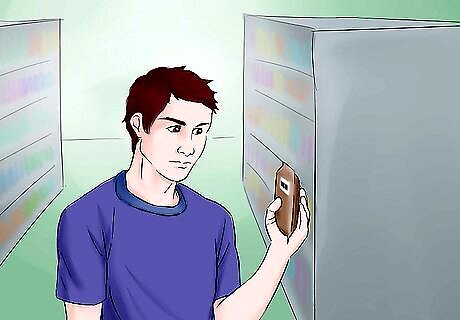
Look the barcode up online for most 12-digit barcodes. The UPC system encodes only the manufacturer's identity and an identification number for the specific product, except in certain cases described in the following steps. More typically, no additional information is included in the UPC system, so there is nothing to gain by attempting to read the barcode yourself. Instead, look it up online using free services such as GTIN's, the official U.S. bar code assignment company, or upcdatabase.org, which is a database created by users. Enter the full 12-digit barcode in the "GTIN" or "Search for a product" fields, respectively. There are a couple exceptions described immediately below this step, in which you can find partial information. GTIN refers to the data system UPC is a part of, short for Global Trade Item Number. 12 digit UPC numbers can be referred to as GTIN-12, UPC-A, or UPC-E.
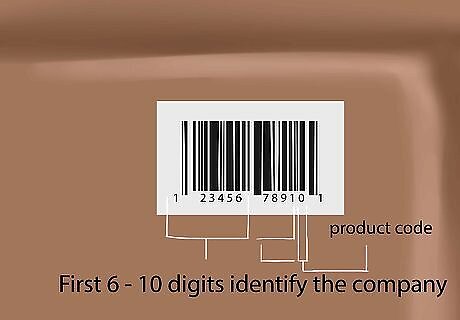
Understand bar code basics. While the 12 digit barcode doesn't contain much human-readable information, you can still learn about how it functions. The first 6–10 digits of a 12-digit barcode identify the company that manufactures or sells the product (either company may choose to add a barcode). This code is assigned and sold by a non-profit organization, GS1, upon request. The remaining digits, except for the very last one, are invented by that company to describe each of its products. For example, a company might be assigned the code 123456. It can then print any 12-digit barcode that begins 123456, creating one for each product. Compare two barcodes from the same company to see whether you can figure out what the company code is. The purpose of the final digit is explained later on in this section.
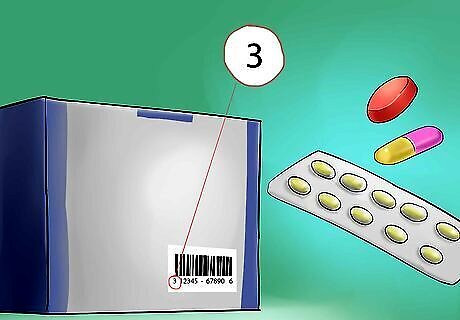
Learn how to interpret the barcode if the first digit is a 3. Drugs, pharmaceutical products, and occasionally beauty products usually have bar codes beginning with 3. The next 10 digits are typically the U.S. National Drug Code number. The process of turning a drug code into a barcode can result in ambiguity, so you may not always be able to check against a drug code listing. Instead, look up the drug code on an online NDC lookup. This type of 12-digit number is sometimes referred to as a UPN, or Universal Product Number. Although drug codes are always 10 digits long, they may also include hyphens (or spaces), which are not shown in the barcode. For example, 12345—678—90 and 1234—567—890 are different drug codes, but only one of them can use the same sequence of numbers as a barcode.
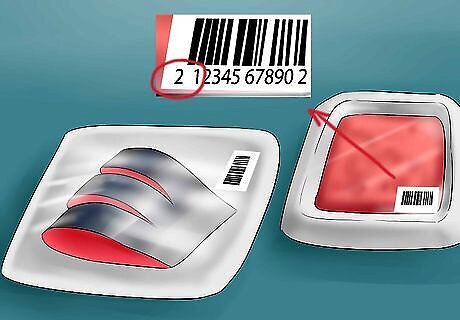
Understand barcodes with a first digit of 2. These barcodes are for items sold by weight. Typically, the first six digits, including the 2, identify the product's manufacturer, and the next five after that are used locally by the store or warehouse to identify the weight of the product, or the price of a particular weight. If you have several products from the same location but in different weights, you may try to figure out the codes for specific weights. Unfortunately, the system is up to each warehouse or store, so there is no universal code to interpret. Type the entire barcode into GSI's company lookup, in the "GTIN" field, to find the manufacturer. This will also show you which part of the barcode is the company prefix (typically the first six digits, but not always). The remaining digits (except for the very last one) should be the code used to denote weight or price.
Learn about the final digit. The final digit is called the "check digit," and is automatically determined by putting the previous 11 digits through a mathematical formula. The purpose of this is to catch printing errors. While fake UPC barcodes do exist, usually created by companies who don't understand that they need to apply for one, it would be easy to include the correct check digit, so this is likely not a reliable method of finding fakes. (For that purpose, look it up in the official database instead.) If you're curious or enjoy doing math for fun, you can enter your barcode into a GTIN-12 check digit calculator, or follow the checking formula yourself: Add all the digits in the odd positions together (the 1st, 3rd, 5th, 7th, 9th, and 11th digits). Multiply the result by 3. Add to this the sum of the even-positioned digits (the 2nd, 4th, 6th, 8th, and 10th) - do not include the check digit itself. "Chop off" everything except the final digit of your answer, the number in the ones place. If that number is 0, that is the check digit. If that number is any other digit, subtract it from 10, and the result is the check digit. For example, if the previous step resulted in an answer of 8, you would calculate 10-8=2. This answer should be the same as the final 12th digit of the barcode.
How to Read UPC Barcodes without the Numbers

Understand this method. Although barcodes are designed to be "read" by scanners and interpreted by computers, it is possible with practice to look at a UPC barcode and translate it into a 12-digit number. This is rarely useful, especially since the 12 digits are usually printed beneath the bars, but you could learn it as a neat trick to show your friends or coworkers. Barcodes using non-UPC systems or different numbers of digits cannot be read using this method. Most barcodes on products sold in the U.S. and Canada are UPC barcodes, but be wary of compressed 6-digit UPC barcodes, which have a different, more complex encoding system.

Find the three sets of longer lines. The barcode should be divided into three sections by sets of slightly longer lines. Look at the bottom of the vertical bars: some of the lines should extend further down than the others. There should be two longer lines at the beginning, two in the middle, and two at the end. These are there to help a barcode scanning machine read the bar code, and do not get interpreted as numbers. However, they still have a purpose in this method: the bars to the left of the central longer lines get read slightly differently than the bars on the right. This is explained in detail below.
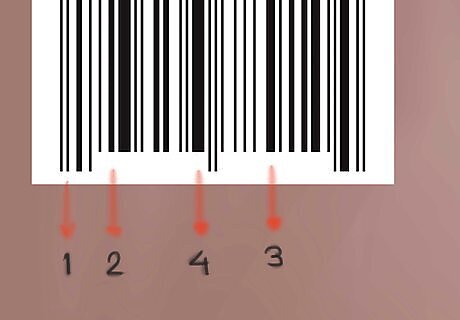
Identify the four widths of the bars. Each vertical bar (black or white) can have one of four different widths. Going from thinnest to thickest, these will be described as widths 1, 2, 3, or 4 for the rest of this method. Using a magnifying glass if necessary, try to figure out the differences in the line widths. Telling the difference between two lines of similar widths can be the hardest part of reading a bar code. Don't confuse this for the actual numbers you're trying to find, the numbers 1 through 4 only describe the width of the bars.
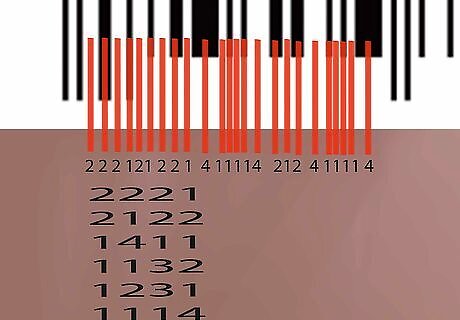
Write down the thickness of the left hand bars. Start with the bars on the left hand side, between the longer bars on the left and the longer bars in the center. Begin with the first white bar on the left hand side, and measure the thickness of each bar, black and white. Each digit in the 12-digit number you're trying to find is encoded using four bars. Write down the thickness of each bar, dividing them into four-bar groups. When you reach the extra-long center bars, you'll have six groups of four digits each. For example, if the first white bar after the extra-long lines on the left hand side is the thinnest size, write down 1. Next, if the black bar to the right is the thickest size, write down 4. Once you've done this for four bars (black and white), leave a space before writing down the next bar. For example, once you've written down "1422," move your pen to a new line before writing down the next bar width.
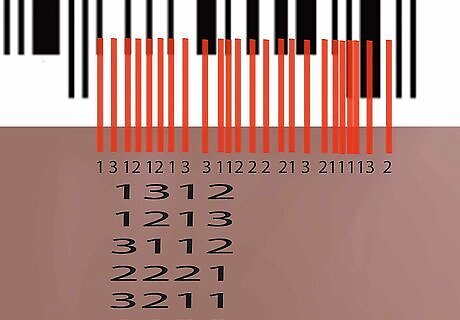
Do the same for the right-hand side, but start with a black bar. Do not decode the extra-long bars in the center. Starting with the first normal-length black bar to the right of them, use the same technique. This time, each group of four bars (representing one digit) will have a black-white-black-white pattern. Stop when you have six additional groups of four digits each, and do not decode the extra-long bars on the right.
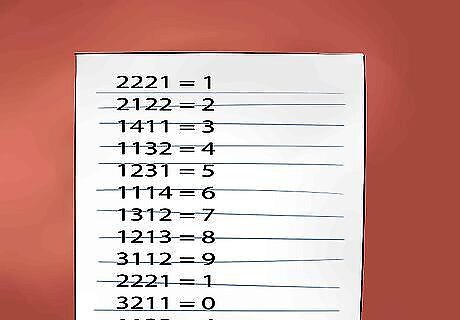
Decode the bar widths into actual numbers. Now that you have figured out which bars (of different widths) correspond to each number, all you need is to know the code that translates these into the actual digits in the 12-digit number. Use the following instructions to do so: 3211 = 0 2221 = 1 2122 = 2 1411 = 3 1132 = 4 1231 = 5 1114 = 6 1312 = 7 1213 = 8 3112 = 9
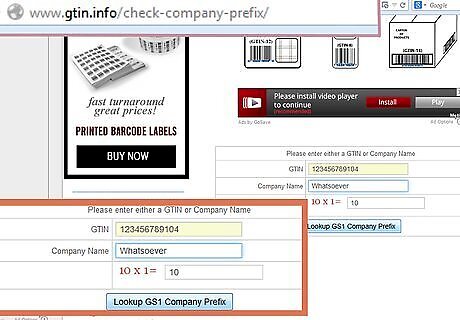
Check your result. If the numbers are printed beneath the bar code, read them to see whether you made any mistakes. You can also look up the product in the GTIN database, typing in the 12-digit barcode you found into the "GTIN" field. This should find any product from a company that was officially assigned a barcode, although sometimes companies mistakenly print their own barcodes that aren't added to the system. Still, most of the time, this database should come up with a product name that matches the item you are looking at, if you read the barcode correctly.















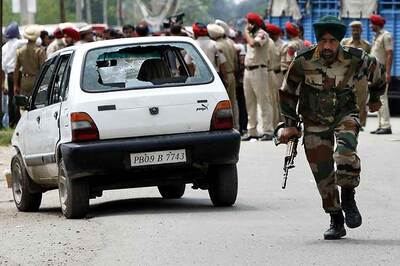
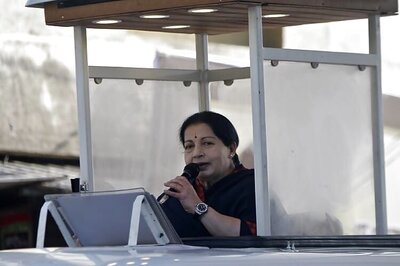



Comments
0 comment